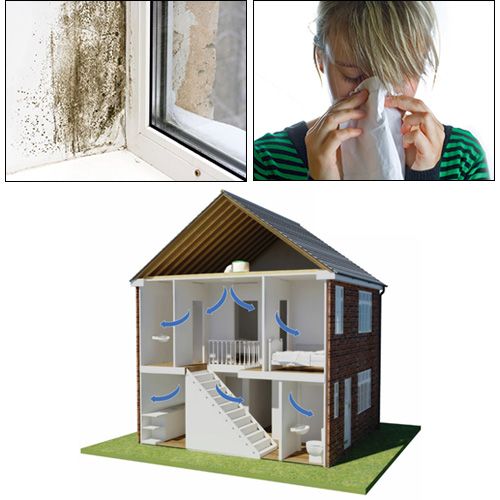

Poor indoor air quality is a growing problem in UK homes, with a recent survey revealing that 20% of householders experiencing condensation and mould growth in the home.
Not only is mould unsightly and damaging to the fabric of a building, it has also been found to aggravate breathing and skin conditions, such as asthma and eczema and so be harmful to health.
So how do you improve indoor air quality and eradicate condensation and mould growth in the home?
1. Dry with care
Householders should try to avoid drying washing indoors, especially on the radiators as this can cause humidity levels to rise which is when condensation starts to form. If there is no other alternative and laundry has to be dried inside, it should be done so in a well-ventilated room, like the bathroom, with the door closed.
2. Create some space
Mould loves tight spots, so it’s best to leave around two inches of space between the furniture and walls to enable the air to circulate around the property. Try to ensure that the wardrobes are placed against internal walls in the bedroom, which will be warmer than external walls and less likely to cause damp and mould problems.
3. Consider a whole house ventilation system
The average four-person family creates 112 pints of moisture every week, from just breathing, cooking, showering and boiling the kettle. To help remove excessive moisture and reduce humidity levels, we recommend a whole house ventilation system.
4. Check the dryer
If the home has a tumble dryer with a ventilation pipe, it is important to check that it runs to the outside of the property, alternatively if it is a condensing model, it must be emptied of water after each use.
This also applies to dehumidifiers, as leaving the water tank full completely defeats the object of having one. However, if a householder does keep a dehumidifier running throughout the day, it should be emptied as soon as possible to reduce the build-up of moisture in the air.
5. Reduce the use of chemical based products
Volatile organic compounds (VOCs) are found in many everyday household products, including cleaning products, deodorant sprays and even scented candles. One of the most common VOCs comes from limonene, an ingredient that is used to give candles and cleaning products their scent.
Householders can prevent this by reducing the use of scented candles and similar items, such as wax melts or oil burners and sourcing cleaning fluids which are environmentally-friendly. These will work in exactly the same way as regular cleaning products, but without causing damage to a person’s health. An effective continuous ventilation system will reduce VOC levels, with many positive health benefits.
6. Hoover regularly
If the bathroom or kitchen has carpets, which can regularly become wet due to bathing and washing, it’s worth considering opting for a tiled or laminated floor instead. This will eliminate nasties such as dust mites, mould and fungi. If this isn’t an option or personal preference is to stick with carpet, then it’s important to make sure it is cleaned regularly, and the space is well ventilated to keep humidity levels to a minimum.
7. Check fans are working properly
A good extractor fan is a key weapon in the fight against mould. Most of the moisture in a house is created in the kitchen and bathroom, so these are the most important areas where extract ventilation needs to be fitted. However, these units can sometimes become blocked or stop working completely, so it is important to check them regularly to ensure they are running correctly.
8. Keep it constant
Condensation can occur when heat levels drop, especially during winter. Keeping the temperature level in the home at a constant will help to avoid this.
9. Ditch the moisture makers
Paraffin and gas heaters produce a lot of moisture and toxic fumes, especially when used in smaller rooms. Not only does this form of heat cause excess condensation in your property, but it can also prove to be a health and safety hazard, so it is best to avoid using these appliances.
10. Have your air quality tested
If a householder is experiencing condensation or mould issues, then it’s a good idea to have a ventilation survey.
With ‘Toxic Home Syndrome’, when the air inside the home is significantly more polluted than that outdoors, now recognised as a serious issue, it is important to ensure that good ventilation is in place. Issues with condensation and mould can easily be eradicated for the long term, without the use of mould sprays or the need for regular redecoration.
